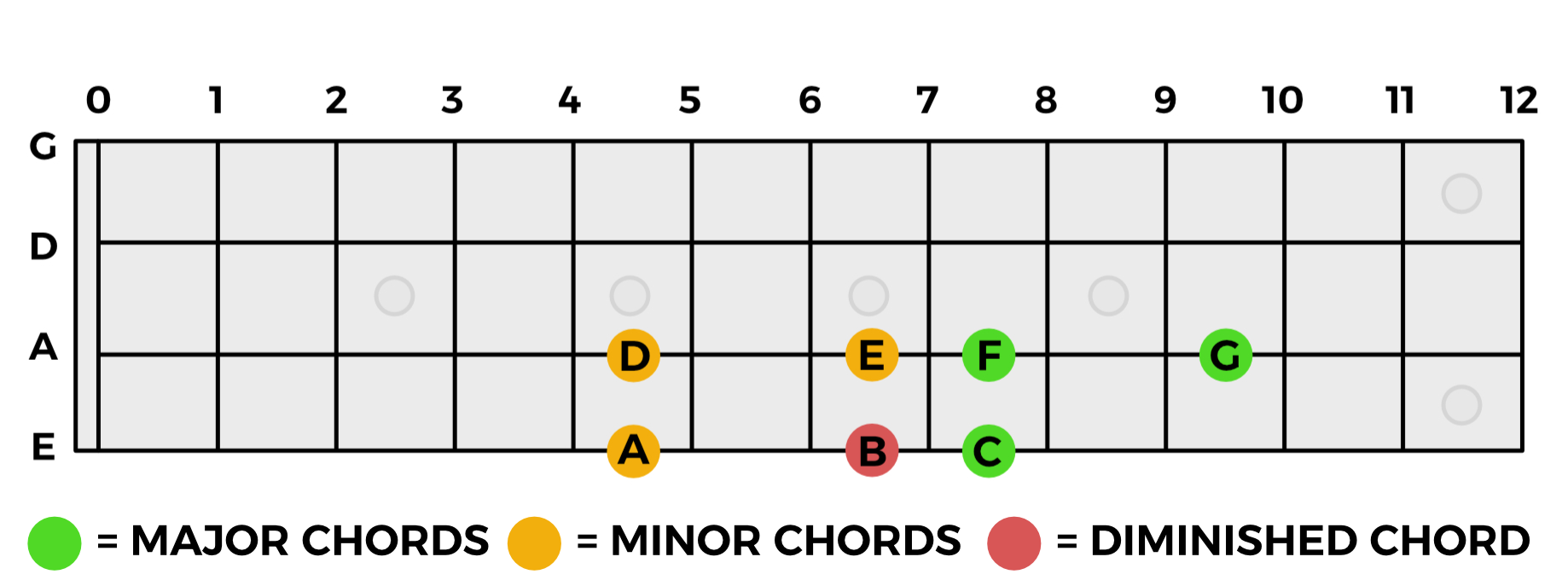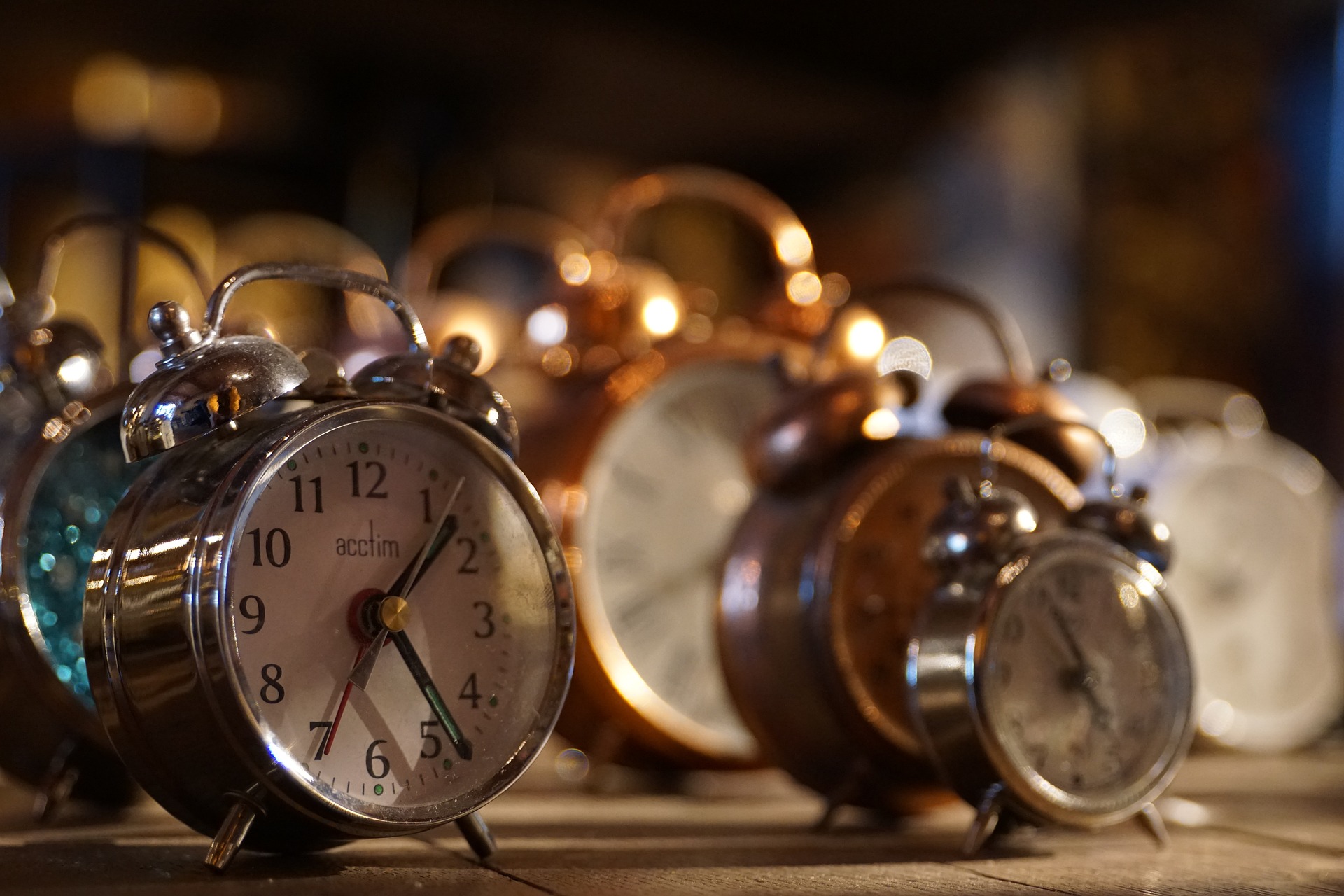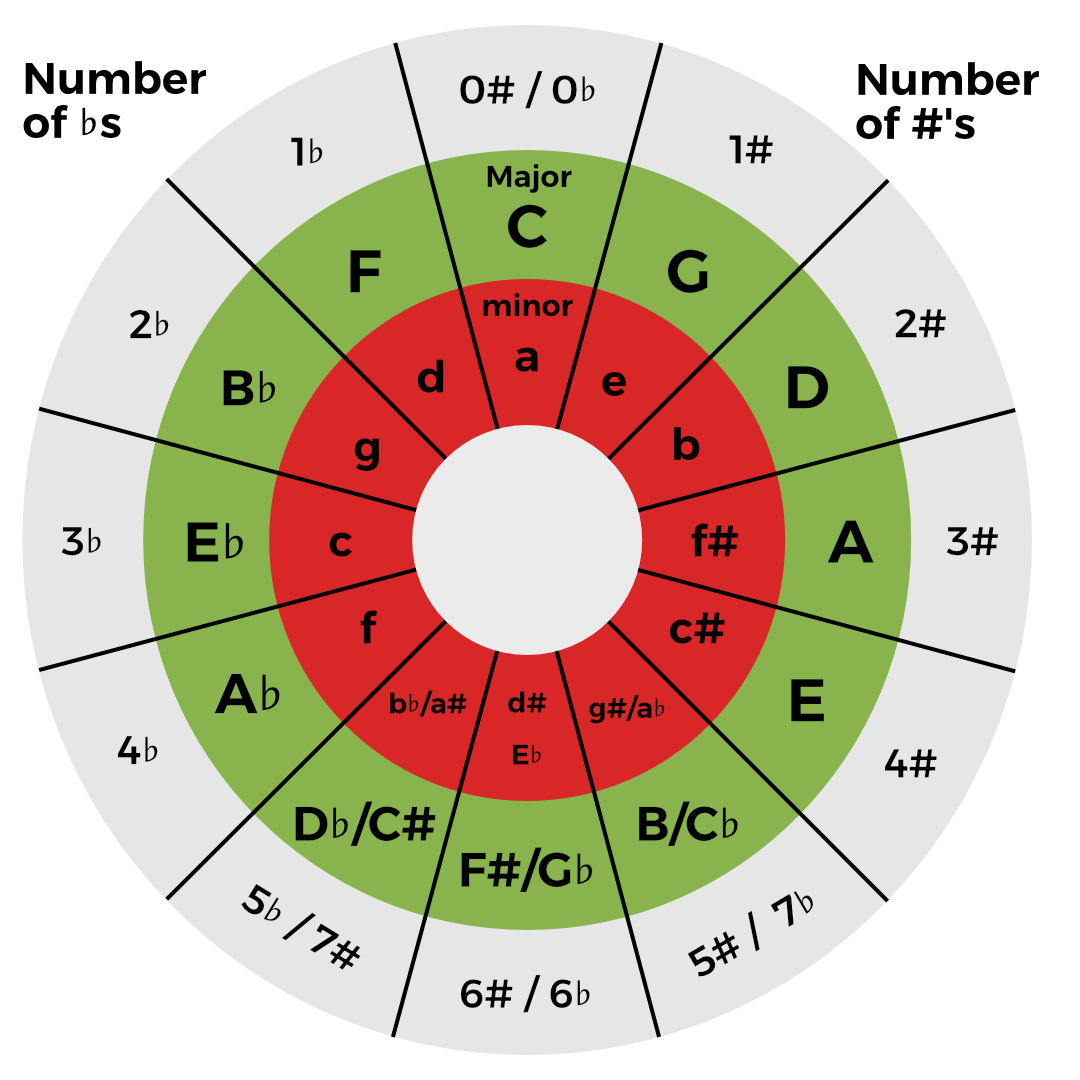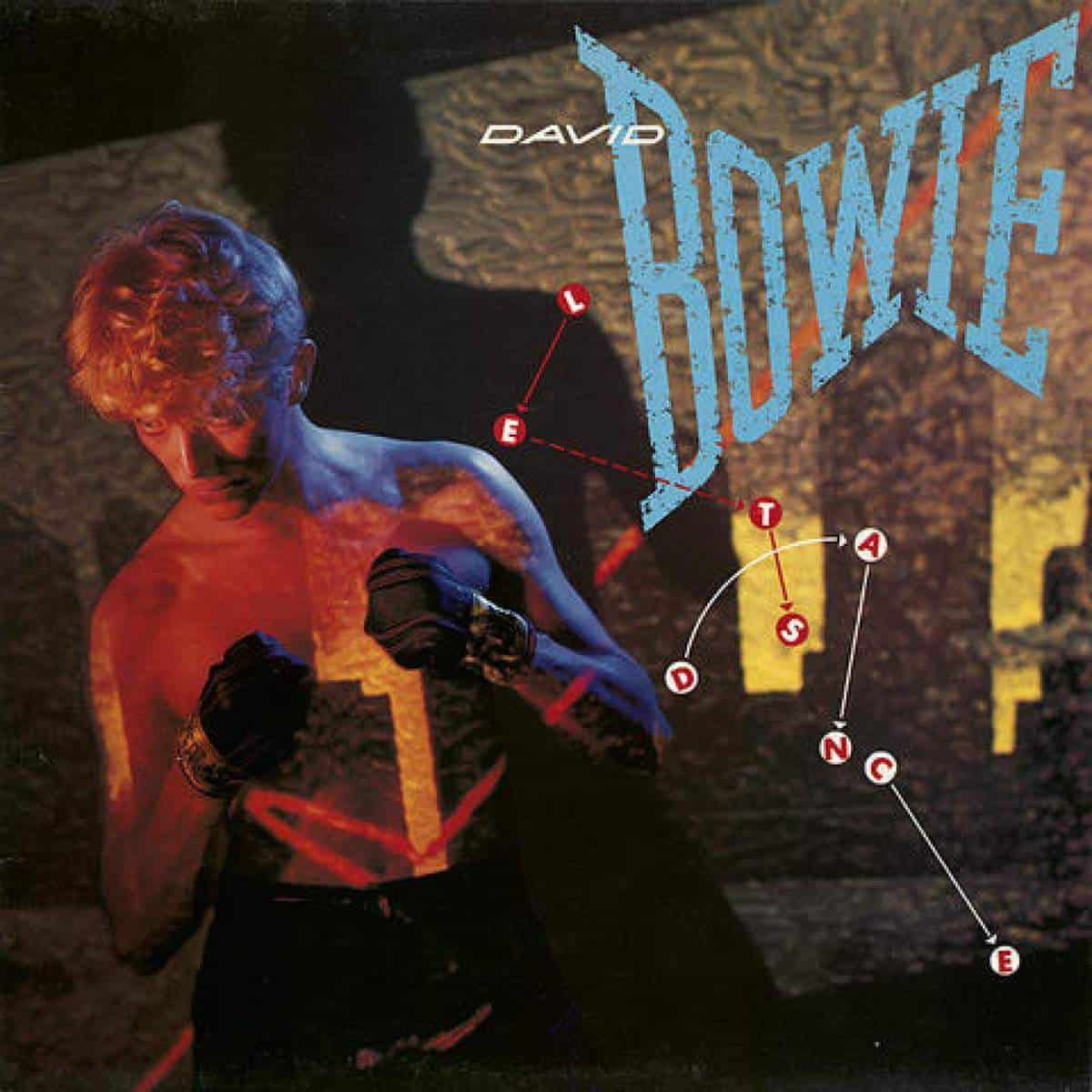
Metric Modulation is a complex issue in music; in the worst, most terrifying cases it involves doing actual math’s!!!
For the most part, though, it can be broken down to changing 2 things: Tempo and Time.
Part 1 will look at Tempo and Part 2 will look at Time.
Things get a bit spicier when you dig deeper into this area and come to learn that there are 2 types of each: Genuine and Implied (or "feel")
These concepts apply to both Tempo and Time based Metric Modulation and they are something that confuses even the most grizzled of teachers and players.
We’re going to look at both Genuine and Implied and explore them both and unpack what it is that causes the confusion.
If you want to skip to the TL;DR explanation of how to tell them apart, click here
Let's go (this is quite long, maybe grab a coffee...)!
Metric Modulation is a very complicated and nuanced area of music and there are many misconceptions around it.
Musicians regularly say things like, "in the chorus we go to half-time and we'll double-time it on the outro..." and somehow most people kind of know what that all means.
But most don't really know, they just play it by instinct and because they're good players, they get it right. I'll bet they don't really know what's happening though...
There are plenty of "Double-Time & Half-Time Decoded!!!" videos on YouTube by music teachers and even they, with all their experience and knowledge, often get it wrong.
Since I transcribe music for this site and have to make choices on which Tempos to used and how to mark up a score for maximum readability, I did some heavy shovel work and soul searching to see if I had really understood it; I think I've come up with a way to explain it that I hope is nice and clear but I'm sure you'll let me know if it's not!
As mentioned above, this is Part 1 of 2 and it will focus on Tempo.
We're going to look at the two types of Metric Modulation of Tempo that happen in music:
First, let's look at some fairly clear examples of Genuine Tempo Change.
*** Fair warning: this is some quite advance theoretical stuff so buckle up my dudes! ***
When it comes to Tempo changes there are a couple of ways to do it that are crystal clear in their intent and execution; there's nothing Implied about them.
These are pretty dramatic, on the spot, obvious changes; you can adjust the Tempo by "chunking" the changes down into say 4 or 8 bar lumps, each getting faster or slower or by gradually playing faster or slower over time...
Below are a couple of examples, with transcrptions and audio (with click), of this "chunked" and gradual change.
Example one is the Tempo changing down in 4 bar chunks and the other is a gradual slide (rall) down in Tempo over 8 bars.

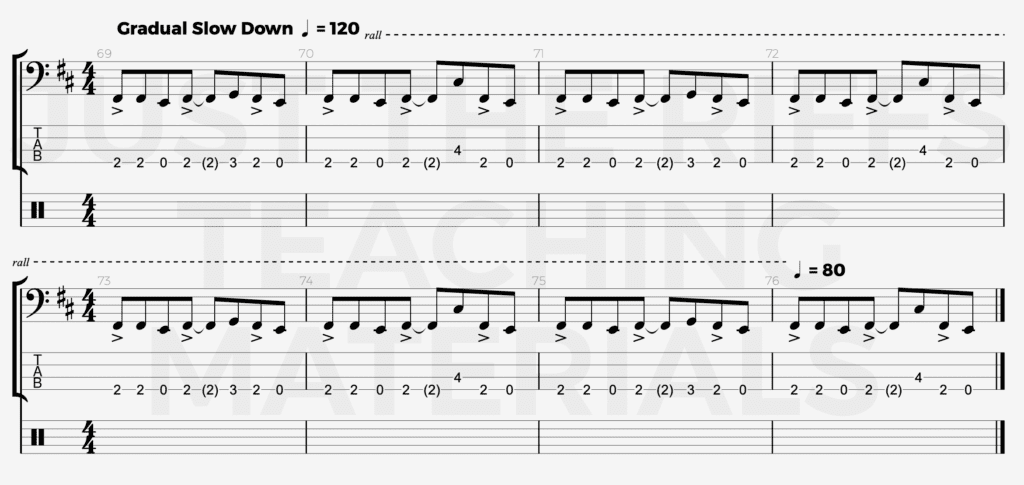
Nice and easy to spot and follow, right? Well, that's the easy stuff out of the way...
(*** Sincere apologies, you are going to get sick of that Riff! ***)
Those two types of Modulation are pretty easy to grasp and they are Genuine Tempo Changes: the music just gets slower or faster in a clear-cut way (this is a very important distinction so remember that you read this!).
Things get more complex when we get into the realm of "Abrupt" changes in Tempo. The confusion comes down to the difference between actually changing the Tempo and just suggesting that you have...
Let's explore...
What is Tempo?
I asked ChatGPT to give me a 1 paragraph defiintion and this is what it came up with:
Musical tempo refers to the speed or pace at which a piece of music is performed, typically measured in beats per minute (BPM).
It determines the timing of the beats, which serve as the foundation for rhythm and timing in a composition.
A higher BPM indicates a faster tempo, while a lower BPM signifies a slower one. Tempo is often indicated in written music with Italian terms such as *Allegro* (fast) or *Adagio* (slow), or by specifying an exact BPM.
Changes in tempo, such as accelerando (speeding up) or ritardando (slowing down), add expressive dynamics and variety to music.
I hope thats clear. (I know it's not...)
At it's core, Tempo simply tells you how fast or slow to play a piece or section.
It can do this in absolute terms (bpm) or in more "suggested" terms like "Allegro (fast)" or "Adagio (slow)" assuming you know your Italian!
Most modern Western music tends to mark up it's notation in more absolute terms (bpm) with "suggestions" (Allegro) in support of them.
Tempo is usually marked at the start of a piece of music (and anywhere it changes in the piece). It has a Note Value Type (Half, Quarter, Eighth, Dotted) and a numerical value that tells you how many of that Note Type Value there are in every minute.
For example:

This Tempo marking states that the music is using Quarter Notes for it's pulse and that in every minute of music under this Tempo there are 100 Quarter Notes.
This Note Value Type can be a Dotted Quarter Note for compound times like 6/8, 9/8 and 12/8 or an 8th Note for Time Signatures like 5/8, 7/8 or 11/8.
All of these affect the bpm (the number) and indicate something about the feel and can lead to some quite complex math's.
For the moment, though, let's stay firmly in Quarter Note country.
Let's say a piece of music starts at 120bpm and in the Chorus it goes to Genuine Half-Time, then the new Tempo is obviously now 60bpm.
If it goes to Genuine Double-Time then it's obviously now 240bpm.
So far so simple...
This is where things start to get a bit... messy.
We've just seen that genuine Tempo changes are reflected in the numerical value of the bpm and will be marked on the sheet music while the Note Value Type stays the same.
In Genuine/Absolute Tempo changes, 120 Quarter Notes per minute becomes 60 Quarter Notes per minute (Half-Time) or 240 Quarter Notes per minute (Double-Time).
It is, however, possible to "suggest", or "imply", that these changes have taken place when technically they haven't.
It's a kind of auditory illusion, a messing about with our perception of time, and while it's very useful it also muddies the waters and leads to a lot of confusion.
This is where we start talking about nebulous things like "feel" and things get kind of confused and mired in our subjective perceptions of time...
Tempo "feel" is one of those things that's ambiguous, that varies from one person's perception to another's, but it's actually quite clearly defined; it's perhaps that sense of it's personally subjectiveness that leads to confusion among even the most grizzled of teachers
In a Genuine Half-Time change, EVERYTHING goes to Half the previous Tempo; if the music is at 120bpm and ALL of the instruments move to 60bpm, that's a Genuine Tempo Change to Half-Time.
In a Half-Time Feel Change, something specific, usually the Drummer, changes what they're playing which affects the overall feel of the music making it now feel slower and weightier than before but, and this is the important bit, the Genuine Tempo of the overall music/piece Has NOT changed.
All of the other musicians are still playing along at the original Tempo.
Mechanically, at it's core, in a Tempo Feel Change, nothing happens to the core Tempo; an instrument within the band simply creates the illusion of a change where this none by playing something that sounds half as fast relative to the Genuine Tempo.
Confused? I'm not surprised. This is heady stuff indeed...
It's not often we get to say this but we need a Drummer!
The Backbeat on the Drums in most Western music is the Snare on the 2 and 4 and I believe that the placement of this, along with other elements like the Hi-Hat/Ride pattern, is what confuses the issue and leads to teachers and musicians getting the difference between Tempo Change and Tempo Feel change wrong.
Let's look at the difference between what happens to the Backbeat in Genuine Half-Time and Half-Time Feel.
A lot of the Drum teachers, and teachers of other instruments out there, start off with a nice mid tempo Rock beat with an 8th Note groove on the Hi-Hats and K-S-K-S pattern on the Quater Notes, often played with and audible click for reference.
Let's say this beat is at a Tempo of 100bpm.
So far so groovy.

Then they'll say, "let's go to Half-Time; notice the Snare is now on beat 3 and we still have that 8th note pattern on the Hi-Hats..." while in the background, the click doesn't change...
Sorry, lads, but this isn't right...
What they've done here is apply a Half-Time Feel, NOT changed to a Genuine Half-Time Tempo.
"How do you mean, Jack?", I hear you ask...
In the teacher's explanation, they say that when they go to Half-Time the Snare is now on beat 3 and that they're still playing that 8th Note pattern in the Hi-Hats.
Well, if you're playing in Genuine Half-Time, ie: you've cut the original Tempo of the song or piece in half, then all of the music and the musicians and the Core Tempo of that music has Modulated to Half-Time (from 120bpm to 60bpm) and you're now simply playing the same pattern you were playing before only half as fast along with everyone else.
This means your Snare is still on the 2 and 4 Backbeat like before and NOT on beat 3 because the music to which it's supplying that Backbeat is ALSO now at 60bpm and half as fast as before.
Nothing has changed in terms of the relationship between the instruments and what they're playing together.
If you're "feeling" the Snare on beat 3 then you've applied a Half-Time Feel in the Drums to music that but the music is STILL AT THE REGULAR TEMPO and in your head you're still counting the original Tempo.
In a Half-Time Feel situation, all the Drums are doing is playing K-r-S-r-K-r-S-r instead of K-S-K-S as before which is simply stretching the 4 beats of one bar over 2 bars and 8 beats while the rest of the band plays everything as before.
I know that's a bit of a word salad/concept dump but give it a couple of re-reads and see if it makes sense to you.
The same goes for Double-Time: if it's genuine Double-Time then everyone is playing the same thing as before only now twice as fast. If it's Double-Time Feel then the Drums are just doubling up on the Kicks and Snares relative to the original Tempo.
Below is a transcription and audio with that riff, the Drums and a click. Pay attention to the click and how it stays the same even when the "feel" of the Drums changes.
In Regular Tempo Feel the Drums are K-S-K-S on the Quarter Notes. When it goes to Half-Time Feel the Drums have the Snare on what feels like beat 3 and the music does feel slower but the Tempo and the click haven't changed.
When it goes to Double-Time Feel the Kick and Snare double up and the riff "sounds" faster but again, the Tempo and the click haven't changed.
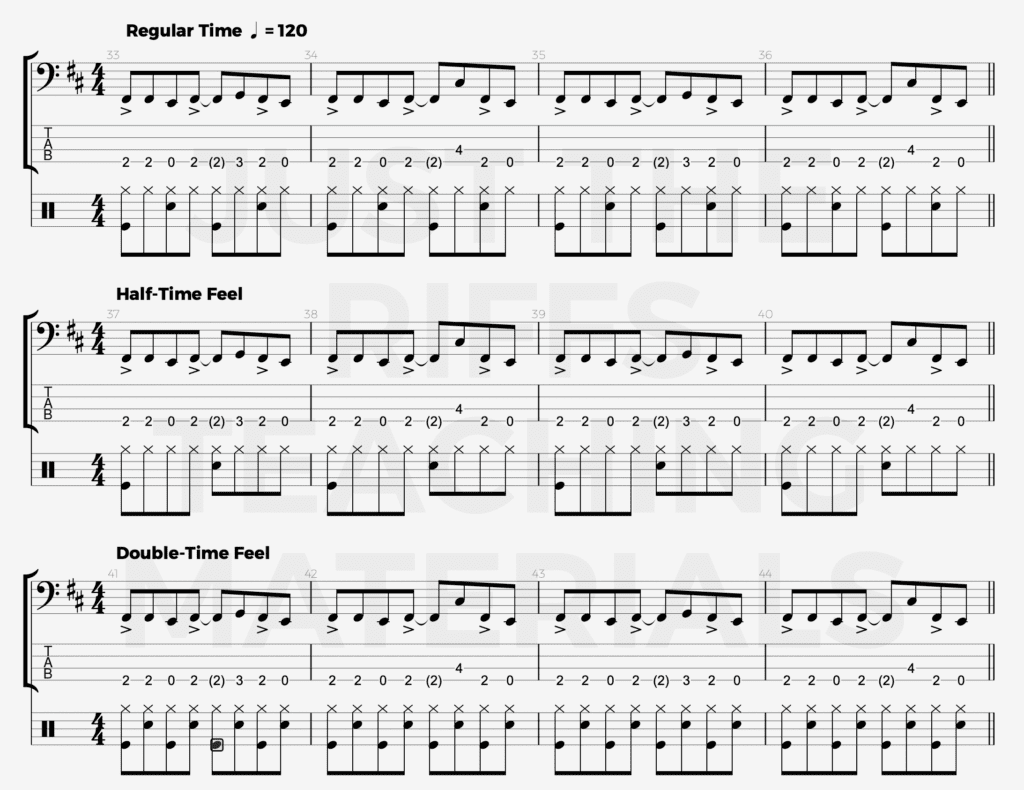
In the examples above, both in the transcription and the audio, the Hi-Hats never change their speed or pattern even though the Drum pattern underneath does.
This is something that quite a few Drum and music teachers on YouTube get wrong about the fundamental difference between genuine Metric Modulation and Implied Metric Modulation; they say that the Hi-Hats are "keeping that 8th note groove" going...
However, if the music were genuinely changing Tempo then, to keep the same driving 8th Note pattern going in the Hi-Hats the Hi-Hats have to change their subdivision from 8th Notes to 16th Notes.
The Drums would look and sound like this at 60bpm in Genuine Half-Time:

If we're hearing the Hi-Hats as being 8th Notes and, in the "Half-Time" line, the Snare is now deemed to be on beat 3 then it's NOT genuine Half-Time but Half-Time Feel because the new "feel" in the Drums is being played and counted in direct relation to the music around it which is STILL PLAYING AT THE REGULAR TEMPO.
It's a bit abstract and hard to grasp so let's get this on it's feet and into the real world.
Below is the notation and audio for the riff (with a click) at Regular Time 120bpm, Genuine Half-Time at 60bpm and Genuine Double-Time at 240bpm.
In the Genuine Half-Time both the Drums and the music are in Half-Time; in the Genuine Double-Time both the Drums and the music are in Double-Time.
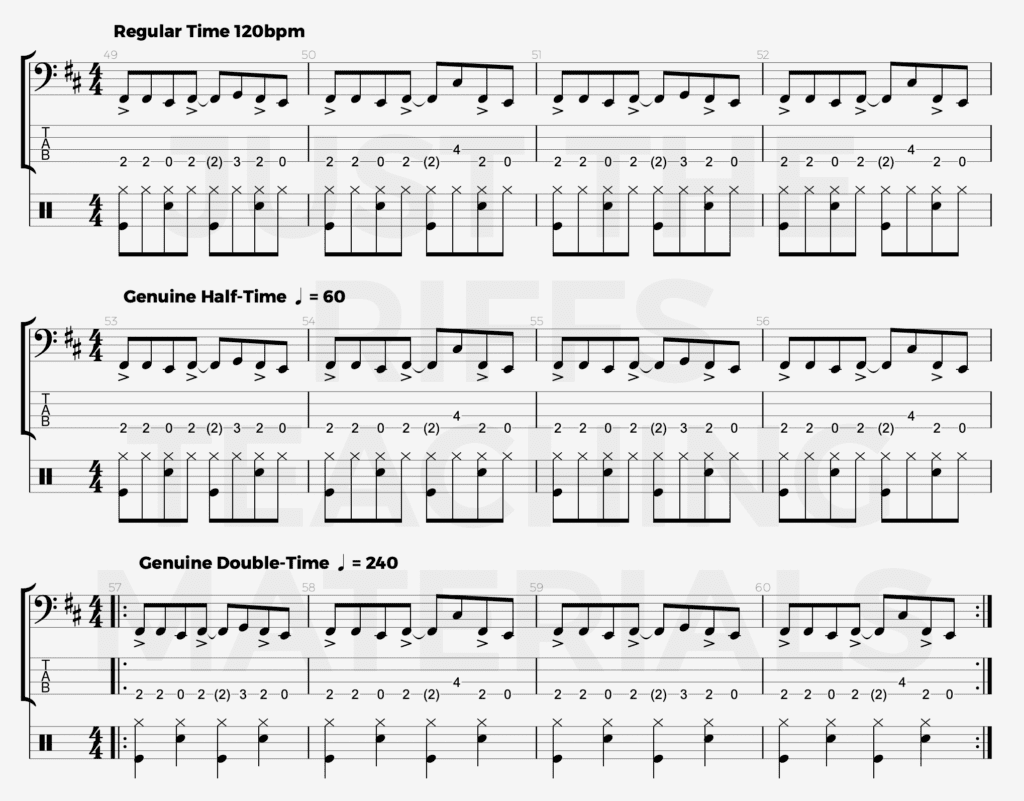
In the example above we are keeping an 8th Note pattern going with the bass riff at both Regular and Half-Time because we are playing the same riff only half as fast, but notice, when we get to Genuine Half-Time, the 8th Notes in the Hi-Hats are now also half as fast!
In Genuine Half-Time you lose the 8th Note Hi-Hat feel from the Regular Tempo if you don't change the Subdivision they're playing from 8th's to 16th's.
In Genuine Double-Time the Hi-Hats go from 8th Notes in the Regular Tempo to Quarter Notes and the riff is now blisteringly quick.
Let's take a moment and quickly compare the differences between
Below is a tab and audio (with click) example showcasing the clear difference between Half-Time Feel and Genuine Half-Time:
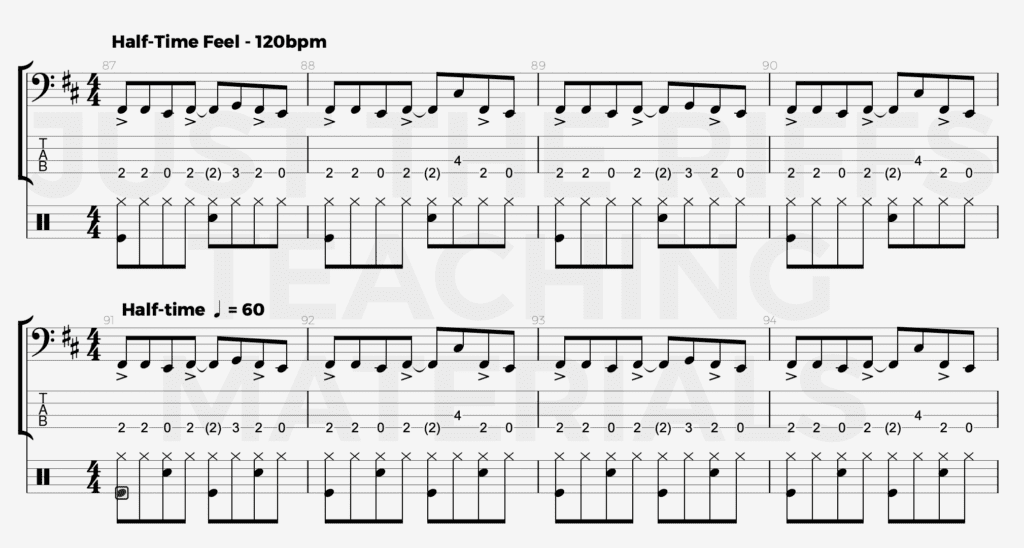
Use these shorthands to tell the difference between an Implied Metric Modulation and a Genuine Metric Modulation:
Hopefully after all this you can hear and feel the difference between these two ideas, between a Relative/Suggested/Implied Tempo Change and a Genuine Tempo Change.
Part 2 coming soon... (when I finish writing it!) It will cover Time Signature changes, both Genuine and Implied (very sneaky) and also touch back on Tempo in terms of changing Times between Regular Times (2/4, 3/4, 4/4) and Compound (6/8, 9/8/12/8) or Odd (5/8, 7/8, 11/8, 5/4, 6/4, 7/4).
Stay tuned. 👍🏽

